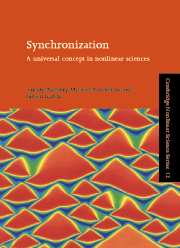Book contents
- Frontmatter
- Contents
- Preface
- Chapter 1 Introduction
- Part I Synchronization without formulae
- Chapter 2 Basic notions: the self-sustained oscillator and its phase
- Chapter 3 Synchronization of a periodic oscillator by external force
- Chapter 4 Synchronization of two and many oscillators
- Chapter 5 Synchronization of chaotic systems
- Chapter 6 Detecting synchronization in experiments
- Part II Phase locking and frequency entrainment
- Part III Synchronization of chaotic systems
- Appendices
- References
- Index
Chapter 2 - Basic notions: the self-sustained oscillator and its phase
Published online by Cambridge University Press: 06 July 2010
- Frontmatter
- Contents
- Preface
- Chapter 1 Introduction
- Part I Synchronization without formulae
- Chapter 2 Basic notions: the self-sustained oscillator and its phase
- Chapter 3 Synchronization of a periodic oscillator by external force
- Chapter 4 Synchronization of two and many oscillators
- Chapter 5 Synchronization of chaotic systems
- Chapter 6 Detecting synchronization in experiments
- Part II Phase locking and frequency entrainment
- Part III Synchronization of chaotic systems
- Appendices
- References
- Index
Summary
In this chapter we specify in more detail the notion of self-sustained oscillators that was sketched in the Introduction. We argue that such systems are ubiquitous in nature and engineering, and introduce their universal description in state space and their universal image – the limit cycle. Next, we discuss the notion and the properties of the phase, the variable that is of primary importance in the context of synchronization phenomena. Finally, we analyze several simple examples of self-sustained systems, as well as counter-examples. In this way we shall illustrate the features that make self-sustained oscillators distinct from forced and conservative systems; in the following chapters we will show that exactly these features allow synchronization to occur. Our presentation is not a systematic and complete introduction to the theory of self-sustained oscillation: we dwell only on the main aspects that are important for understanding synchronization phenomena.
The notion of self-sustained oscillators was introduced by Andronov and Vitt [Andronov et al. 1937]. Although Rayleigh had already distinguished between maintained and forced oscillations, and H. Poincare had introduced the notion of the limit cycle, it was Andronov and Vitt and their disciples who combined rigorous mathematical methods with physical ideas. Self-sustained oscillators are a subset of the wider class of dynamical systems. The latter notion implies that we are dealing with a deterministic motion, i.e., if we know the state of a system at a certain instant in time then we can unambiguously determine its state in the future.
- Type
- Chapter
- Information
- SynchronizationA Universal Concept in Nonlinear Sciences, pp. 27 - 44Publisher: Cambridge University PressPrint publication year: 2001
- 1
- Cited by

